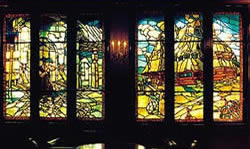|
The hall got its name from the
two triple Venetian mirrors situated at the two ends of the
hall. But the twelve stained glass windows made it really
famous. Thoroczkai-Wigand Ede and Nagy Sándor painted these
windows and they were made in Róth Miksa's workshop in Budapest
(1913).
The peripheral windows of the
hall were made after Thoroczkai-Wigand Ede's paintings. Their
themes are taken from Szekler folk legends, and they illustrate
the Szekler's material-social and spiritual ethnography, architectural
styles, housing, family life, important works.
 |
 |
In the first
group from left, we can see three pictures: Once upon a time,
The Gate of the Great Lord (on the last picture on the left,
bottom), Tent Palace (near, on the right). The windows on
the right side are more connected with the Hungarian legend
circle: Réka's tent-garden (fragment of this can be seen in
the last picture, on the left, top), Csaba's Cradle (near,
on the right). There are also two small window paintings;
one of them is Réka's plank window. The Szekler ballad scenes,
made after Nagy Sándor, the painter's plans are placed in
the middle of the outer wall, between the columns in the nook.
|
|
|
|
Budai Ilona (The
Cruel Mother)
|
Salamon Sára
|
Of the four
ballads on the left the first is the ballad of Budai Ilona
(The Cruel Mother). The main character is the mother, who
treats her children cruelly. The relatives of this ballad
can be found in the European folklore. The first window picture
presents Budai Ilona with her "precious little box of
jewels", her "little maiden daughter" and on
her right her "little running son". The second window
picture presents the scene when she gets frightened hearing
the horses galloping and "puts down her little maiden
daughter" to have her treasure safer. The little girl
doesn't want to believe her mother's cruel decision and asks
for mercy. The third window picture presents the mother, who,
regretting deeply her cruel deed, has returned from her journey.
The second ballad is Salamon
Sára. On the left window the girl dressed in the richly decorated
"muszuj" from Kalotaszeg rides impatiently to Italy
to her lover. On the central window picture we can see the
seduced girl in the arms of the devil. On the right picture
the dead girl is lying on the ground, only her faithful horse
is guarding her sympathetically.
|
|
|
|
Kádár Kata (The
Two Zion Flower)
|
Beautiful Julia
(The Girl Taken to Heaven)
|
The third
stained glass painting is the ballad of Kádár Kata (The Two
Zion Flower). This ballad is the tragedy of the forbidden
marriage by the feudal-social differences. The lovers find
each other in death. This story can be found in both European
folklore and poetry: In the first window picture we can see
Gyulainé, who proudly turns away from her son's will to take
Kádár Kata (the daughter of their serf) to wife. The second
picture illustrates the girl thrown into the bottomless lake.
The third picture illustrates the eternity of love symbolized
by two blossoms as they are bound together. Nagy
Sándor's fourth window picture illustrates our probably oldest
ballad from the XIth century: entitled Beautiful Julia (The
Girl Taken to Heaven). The theme is religious in which pagan
and Christian elements are mixed together. The first window
picture shows the beautiful Julia on knees, picking cornflowers.
In the second picture she observes
the heavenly envoy, the white lamb that trends towards her.
Between his horns, the lamb brings the Sun and the Moon and
he has on his two sides two, lit candles. The artist haloes
the lamb, to relieve the heavenly glory, which follows God's
envoy. The third picture illustrates the bevy of virgins that
is taken into heaven. Beautiful Julia says goodbye to her
mother to be taken with the saint virgins.
The four ballads use the folklore's treasure, and the Hungarian
folk secessionist Nagy Sándor paints the themes of these folk
ballads in a modern way. With dynamism he emphasizes their
inner consistency and the tragic relieving the important ballad
elements. Consistency and the tragic are the main features
of the Hungarian folk ballads.
Above the triple windows of
the ballads we can see the same symmetrically settled flower
pattern with flowery dome, which emphasize the folk secessionist
style. Nagy Sándor's painted cartoons were painted on glass
plates and put in lead frames in Róth Miksa's worldwide famous
workshop in Budapest. The color shades and the painting style
were attained in the highest artistic level, using the light
effects from outside emphasizing the main characters and the
message. Below the pictures the quotations were painted on
white glass with letters of the secessionist style.
Bernády György, the mayor (1902-1913; 1926-1929) had invited
the most prestigious artists of the art settlement in Gödöllő
(Gödöllői Művésztelep) to decorate this secessionist architectural
jewel-box, the Palace of Culture, in which, no doubt, this
hall is the most beautiful gem.
|

